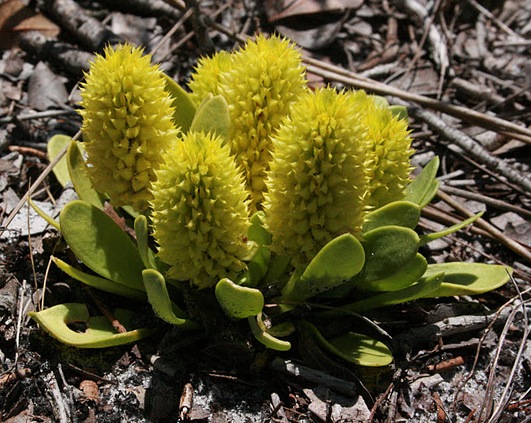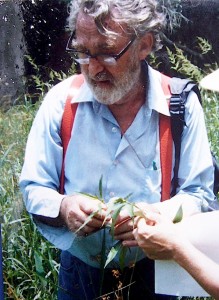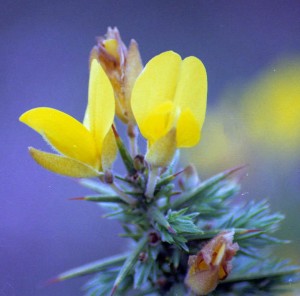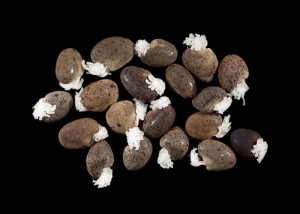I will be the first to admit my experience with Candyroot is very limited. In a flower book I carried with me on field trips some 28 years ago with Florida forager Dick Deuerling I have written: Root chewed, can also make a tea.
That is scant. I did not note it is edible, just chewable. I can remember where we found it, a single plant growing in the middle of a woodroad. Getting an elaboration from Dick isn’t possible because he passed on some nine years ago at age 92. It’s low profile might explain why little is published about the plant regarding edibility… well, it’s not really “edible.” Chewable and drinkable are more accurate. Dr. Daniel Austin who managed to write more than two pages about the genus in his book Florida Ethnobotany, writes: “Milkworts are everywhere in the pine flatwoods in late April. Sometimes thousands of plans belonging to nine species will be in view on ridges and swales.”
Generally said there are two groups of Polygalas in North America, those that have roots that smell like wintergreen or licorice, and those that don’t (nose opinions vary.) Florida’s Seminoles had specific plant names but also used them generically making it confusing as there are 23 different species of Polygalas in Florida. The Creeks used Polygala lutea for medicinal uses but also had just one word for all the Polygala species, hi:lamásî, meaning roughly medicine, use, tea. The Choctaw called P. lutea “kwonokashaipsa” which means “little people eat it.” Incidentally, Polygal lutea means “much mik yellow” and it is called the Yellow Milkwort though it can also reach orange in color.
The Polygalas certainly have been medicinal — including emetics — and have a variety of names around the region including: Bachelor Buttons, Drum Heads, Gay Wings, Bird-on-Wings, Baby Toes, Baby’s Feet, Baby Slippers, Satin Flower, Indian Pink, Maywing, Procession Flower and Rogation Flower, the latter two for making garlands to wear in religious ceremonies.
In northern climes of North America Polygala seneca, aka Snakeroot, was a common herbal medication and is the only member of then genus in the new world to be written about to some extent. It contains, among many chemicals the wintergreen smelling methyl salicylate. Snakeroot has been used to treat not only snakebite — questionably — but colds, croup, pleurisy, rheumatism, heart issues, coughs, convulsions and externally for swellings. It can be an emetic, an expectorant and a diuretic. Florida’s Polygala boykinii also has methyl salicylate.
Like Gorse, the seeds of the Polygalas are spread by ants. No ants, no Polygalas. As one might imagine that means the plants don’t move too far too fast. The seeds have elaisomes, which are fleshy structures attached to seeds that are rich in oil and proteins. Indeed, “elaisome” comes from two Greek words, “elaion” meaning oil and “soma” for body. The ants take the seeds into the nest, eat the elaisomes, then dump the seeds outside the nest. The seed then finds itself in an open space sitting in rich decaying material, not a bad start in life when you’re a plant.
Elaisome is said ee-LAY-eh-psalms, which isn’t good Greek but it is far better than Dead Latin’s ee-LIE-eh-psalms. The native Greek ear would prefer a third way, eh-LAH-ee-shoms as oil is LAH-dee and body is SHO-ma. Of course, Candyroot is much easier.
Botanically this Candyroot (several are called Candyroot or candyweed) is Polygala nana (poh-LIG-uh-la, NAh-nah.) Polygala means much milk. The species in the genus, some 550 of them, were thought to increase lactation. Nana means small.
To help you sort out some species: Polygala cruciata, Drumheads, flowers pink-violet in tight cylindrical raceme. Polygala cymosa, Tall Pinebarren Milkwort, plants two feet tall. Flowers yellow in cymes. Polygala incarnata, Procession Flower, violet, in narrow cylindrical heads much longer then wide, individual flowers angled upward. Polygala lutea, Orange Milkwort, four inches tall, a tight raceme, orange. Polygala nana. Candyroot, plants four inches tall, flowers in a tight raceme, yellow. Polygala rugellii, Yellow Milkwort, flowers in dense yellow raceme, looks like P. nana but is much taller than four inches. Polygala violacea (P. grandiflora) Showy Milkwort, flowers purple, with two large ears. P. nana does not grow south of Broward County but P. smallii does, however it is endangered. P. violacea will make you vomit and P. rugelii is a laxative among other things.
Green Deane’s “Itemized” Plant Profile: Candyweed
IDENTIFICATION: Polygala nana: A small rosette of spatula-shaped nearly succulent basal leaves about 1-2 inches tall. Rabbit’s-foot heads of flowers within the rosette a few inches taller that the leaves. Flower petals are lemon yellow united to form a tube in compact racemes. Leave mostly sessile, succulent, spathulate.
TIME OF YEAR: An annual, it blossoms in spring but can extend into summer
ENVIRONMENT: Moist soil, usually open pinelands in low pockets. This particular species if found in the Old South from the Atlantic seaboard to Texas.
METHOD OF PREPARATION: Roots chewed for flavor, not consumed. Or root soaked in hot water for a tea. As the genus can be emetic and medicinal, caution is recommended.





